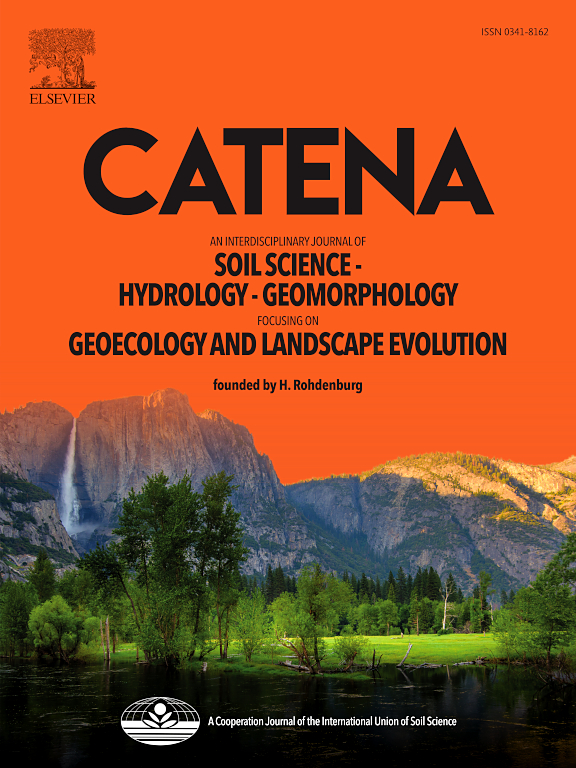Impact of river regulation on gravel bar decline and vegetation expansion over recent decades
IF 5.7
1区 农林科学
Q1 GEOSCIENCES, MULTIDISCIPLINARY
引用次数: 0
Abstract
Many gravel-bed rivers in the Carpathians have undergone extensive regulation that has completely changed their geomorphic regime. Formerly rich in gravel bars, these river systems are now deprived of geomorphologically effective flows and sediment supply, resulting in the disappearance of gravel bars or the loss of their natural dynamic behavior due to vegetation overgrowth.
This study examines the effects of regulations on the development of gravel bars by comparing the historical condition in the 1950s (with limited human influence) with the recent period (2000–2022), and by analyzing the effectiveness of hydrological events and the development of in-channel vegetation in the recent period, in two heavily regulated gravel-bed rivers: the dammed Ostravice and the free-flowing Olše.
Rivers with abundant gravel bars underwent extensive channel regulations in the 1950s, which significantly reduced bar widths and lengths, as well as the total area of gravel bars. Hydrologically effective flows during bar reworking were associated with large floods (1997, 2010) or high flows in 2014, an effect facilitated by the previous flood event and the lack of resistance of highly vegetated bar surfaces. The remainder of the study period experienced progressive vegetation succession or only partial bar reworking. Overall, the dammed river showed more profound shifts in gravel bar morphology towards progressive bar narrowing and elongation and rapid vegetation succession than the less regulated river. This study provides insights into the development of gravel bars in regulated rivers of Central Europe, and highlights, from a management perspective, the potential loss of ecologically valuable habitats.
近几十年来河流整治对沙坝退化和植被扩张的影响
喀尔巴阡山脉的许多砾石河床经过了广泛的治理,完全改变了它们的地貌制度。这些河流系统以前富含砾石坝,现在由于缺乏地貌上有效的流动和沉积物供应,导致砾石坝消失或由于植被过度生长而丧失其自然动力行为。本研究通过比较20世纪50年代(人类影响有限)与最近时期(2000-2022年)的历史条件,并通过分析最近一段时间内水文事件的有效性和河道内植被的发展,考察了法规对砾石坝发展的影响,这两条严格管制的砾石河床河流:筑坝的Ostravice和自由流动的Olše。20世纪50年代,沙洲丰富的河流进行了广泛的河道整治,大大减少了沙洲的宽度和长度,减少了沙洲的总面积。沙洲改造期间的水文有效流量与大洪水(1997年、2010年)或2014年的大流量有关,这是由于之前的洪水事件和植被丰富的沙洲表面缺乏阻力而促成的。其余的研究期经历了渐进的植被演替或只是部分的沙洲改造。总体而言,坝后河段砾石坝形态向逐渐变窄、变长和植被快速演替方向转变更为深刻。这项研究提供了对中欧受管制河流中沙砾坝发展的见解,并从管理的角度强调了生态价值栖息地的潜在损失。
本文章由计算机程序翻译,如有差异,请以英文原文为准。
求助全文
约1分钟内获得全文
求助全文
来源期刊

Catena
环境科学-地球科学综合
CiteScore
10.50
自引率
9.70%
发文量
816
审稿时长
54 days
期刊介绍:
Catena publishes papers describing original field and laboratory investigations and reviews on geoecology and landscape evolution with emphasis on interdisciplinary aspects of soil science, hydrology and geomorphology. It aims to disseminate new knowledge and foster better understanding of the physical environment, of evolutionary sequences that have resulted in past and current landscapes, and of the natural processes that are likely to determine the fate of our terrestrial environment.
Papers within any one of the above topics are welcome provided they are of sufficiently wide interest and relevance.
 求助内容:
求助内容: 应助结果提醒方式:
应助结果提醒方式:


